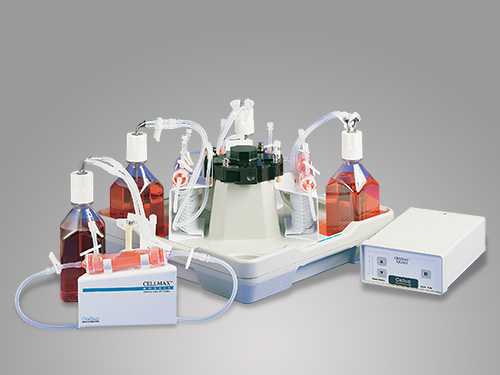
三维细胞培养系统
产品名称: 三维细胞培养系统
英文名称: CELLMAX®
产品编号: cellmax
产品价格: 0
产品产地: 美国
品牌商标: Spectrum的CELLMAX®
更新时间: null
使用范围: null
武汉科力瓦贸易有限公司
- 联系人 :
- 地址 : 武汉市武昌区徐东村徐清公寓7栋4单元501
- 邮编 : 430062
- 所在区域 : 湖北
- 电话 : 159****8565
- 传真 : 027-86610422
- 邮箱 : 61feng@163.com
中空纤维细胞培养系统
Spectrum的CELLMAX®人工纤维细胞培养系统与摇瓶、滚瓶等传统的培养技术如相比,能更好的模仿细胞在体内的生长及产物代谢。在CELLMAX®反应器中,细胞围绕人工中空纤维网三维方向生长,纤维管输送营养及溶氧带走代谢副产物和CO2。人工纤维细胞培养能得到更高的细胞密度及蛋白产量,同时保持较高的细胞活性。更小的纤维空间能将分泌产物浓缩,收集容易。系统结构简单、分泌产物纯净!
|
人工纤维反应器的优点
|
传统细胞培养设备的缺点
细胞的benefit
|
MWCO:含义及细胞培养的重要性。
膜的截留分子量(MWCO)是用截留百分比间接表示化合物大小的一种方法。MWCO的标准测量单位是道尔顿(Dalton),即一个氢原子的大小。既然MWCO是测量大小的方法,不能将其直接转化为公称直径。关于长度尺寸与MWCO对照的图表、过滤的基本知识请电话告知我们接收您的申请。
营养及废产物的扩散不会对影响膜的通透性,只有决定在ECS(纤维外空间)中收集产物还是让其进入培养基中时才需要考虑孔的大小。
为如何选择最适合您使用的反应器,下面是几条指导意见:
用于收集分泌产物的贴壁细胞
用再生纤维素或聚砜膜。在ECS(纤维外空间)中接种细胞。较大的比表面积使得在较小空间内能培养大量的细胞。孔径较小,可以在ECS(纤维外空间)中收集浓缩的分泌产物。
用于剪切力研究的贴壁细胞
用聚丙烯涂层或聚乙烯材质的反应器进行剪切力实验。内径较大,可以将细胞接种在纤维内表面上,测定培养基流速对贴壁细胞的影响。
用于非分泌产物收集的贴壁细胞
任何一个反应器皆可。如果培养细胞数量较多,选择一个表面积较大的反应器。
悬浮细胞
所有的悬浮细胞系都要接种在ECS中。用再生纤维素或聚砜膜。如果不收集产物,可用聚丙烯及聚乙烯膜。
CellMax Duo人工毛细管细胞培养系统
三维细胞培养
CELLMAX® DUO系统的特点是具有两个泵站且可以培养基瓶,能够分别容纳两只CellMax® 中空纤维反应器和培养基瓶同时进行两个独立的细胞培养。该系统结构紧凑可放入标准的潮湿温控CO2培养箱,所有的表面可以用酒精稀释液擦拭转移到组织培养柜中。
泵通过推压每只中空纤维反应器上的管路驱动培养基流出培养基瓶循环通过反应器,这种方式降低因管壁颗粒的脱落进而阻碍细胞生长的风险。硅胶管具有气体通透性,可以允许CO2自由扩散,维持培养液pH恒定。CellMax® Duo系统可以调节的流量范围为5-120mL/min。特殊的推动闩设计允许使用者利用单个泵进行低流量培养,而另外一个泵可以维持高流量。也可以选用灌注套装实现纤维外空间(ECS)的流量循环,降低微环境条件可能对细胞培养产生的伤害。
泵基座通过一条电源线与外部电子控制单元(ECU)连接,ECU背面有磁性可以贴附在培养箱的外壳上。ECU有11个档位进行流量调节。
CellMax Quad系统
同时操控四个培养过程
CELLMAX® Quad人工纤维细胞培养系统是专门为哺乳动物细胞的培养而设计的。
CELLMAX® Quad的特点是位移泵装置提供压力保证人工纤维反应器的长期培养,精确控制12种流速。调节范围广的流速对特定剪切力条件下的内皮细胞研究非常有用。
该系统可同时操控多达四个分离、独立的反应器。该系统最大的满足你的需求,对于无论是同时进行几种细胞系的培养,还是在单个系统里进行单个类型细胞的重复研究,它都是一个理想的选择。
CellMax® 细胞培养系统的应用:
单克隆抗体生产
当需要在体外生产50毫克至几克的单克隆抗体时, CELLMAX®人工纤维细胞培养系统是个不错的选择。用到的纤维质纤维的截留分子量(MWCO)为30kd。抑制因子TGFbeta(转化生长因子β)能自由扩散,较纤维外空间(ECS)中。细胞密度能多于108/ml,抗大分子量的免疫球蛋白类则与杂交瘤细胞一起留在体的浓度范围为0.5mg-5mg/ml。收集液的体积仅为10-20ml,每个反应器能够持续生产抗体长达4-6个月。血清可逐渐减少,逐步适应无血清的培养基。嵌合型非小鼠抗体的生产很容易,减少或消除了生理污染物如类酯、内毒素、蛋白及病毒的影响。净化简便,总产量得到改善。
内皮细胞培养
Spectrum已开发了几种人工纤维细胞培养反应器,可用于内皮细胞的培养及对其在流动条件下的研究。与其他方法相比,该系统更接近生理环境,可以进行细胞功能的评估。细胞形态呈现出与体内条件接近的结果。
CELLMAX® Quad提供了与静脉或动脉血相接近的剪切力水平。另外,纤维管的微孔特性为平滑肌、脑神经胶质细胞等血管外周细胞的共培养创造了一个理想的模型。
上图是剪切力为13-15dynes/cm2的似动脉条件下,在CELLMAX®中培养的内皮细胞的扫描电子显微照片。纤维管纵向剖开后,可以看到中空纤维外壁表面附着一层细胞。经人工处理后,单层细胞的一边已经部分脱离了纤维内表面,表明了内皮细胞层具有的粘附特性。
分泌蛋白生产
目前的生物分泌物如生长因子、重组蛋白及抗体的生产及收集,使用的是效率低下的体外培养系统或动物。CELLMAX®人工纤维细胞培养系统能够在体积小(10ml-100ml)的纤维外部空间进行高密度(高达5×1010个细胞)的细胞培养。纤维管独特的分子截留能力能够将分泌产物截留在小空间中,小分子营养及代谢废物则可以自由扩散到循环培养基中。使用CELLMAX®系统,无论是产物的总浓度还是单个细胞的分泌量都能增加到原来的10倍或更多。缩小的生产空间及低血清或无血清培养基的使用简化了生产后的净化。
美国Spectrum中空纤维细胞培养系统CellMax
| ||||||||||||||
 |
 |
 |
 |
 |
Bioreactor Cartridge Components and Features
Designed for the full range of Cell Culture applications the CellMax Bioreactors feature:
- 4 Membrane Chemistries including:
- Regenerated Cellulose (RC)
- Polysulfone (PS)
- Polypropylene (PP)
- Polyethylene (PE)
- ProNectin® F coated Polyethylene and Polypropylene for enhanced cell adherence.
- Surface areas ranging from 100 cm2 to 1.6 m2
- Animal Derived Component Free
- Fully Assembled with Flowpath and Preflushed
- Irradiated and Ready to Use
- 100% Integrity tested
Clave® Aseptic Access Ports
An important feature of the CellMax Bioreactor is the Clave Aseptic Access Ports which:
- Reduce the risk of cell culture contamination
- Provide easy access to the ICS (Intra Capillary Space) for monitoring glucose and lactic acid levels.
- Provide easy access to the ECS (Extra Capillary Space) for Cell Inoculation or Protein Harvest
Selection of a bioreactor is based on a variety of factors, such as cell line, cell culture application, and performance requirements. The following is a guide to assist in selecting a bioreactor.
| CellMax Hollow Fiber Bioreactor Selection Guide: | |
| Adherent cells for collection of secreted products: | RC or PS membranes Cells seeded in the ECS will grow on the surface of the membrane and allow secreted products to concentrate into the ECS media. Depending on the size of the secreted product, select an appropriate MWCO to prevent the protein from permeating through the hollow fiber pore. |
| Suspension cells for collection of secreted products: | RC membrane The Regenerated Cellulose (RC) membrane is typically preferred. The hydrophilic surface prevents the secreted product from binding to the membrane. This ensures higher titers during harvests and efficient use of the membrane to supply nutrients and eliminate metabolic waste. |
| Adherent cells for shear stress and gas diffusion: | PP or PE membrane The hydrophobic membrane allows gas to diffuse freely while preventing passage of peptides and proteins, similar to epithelial tight junctions. The large lumen allows you to seed the cells onto the inner capillary surface (inner side of the hollow fiber) and to measure effects of media flow on the adherent cells. These membranes can be coated to enhance cell adhesion and are offered pre-coated with ProNectin F. |

